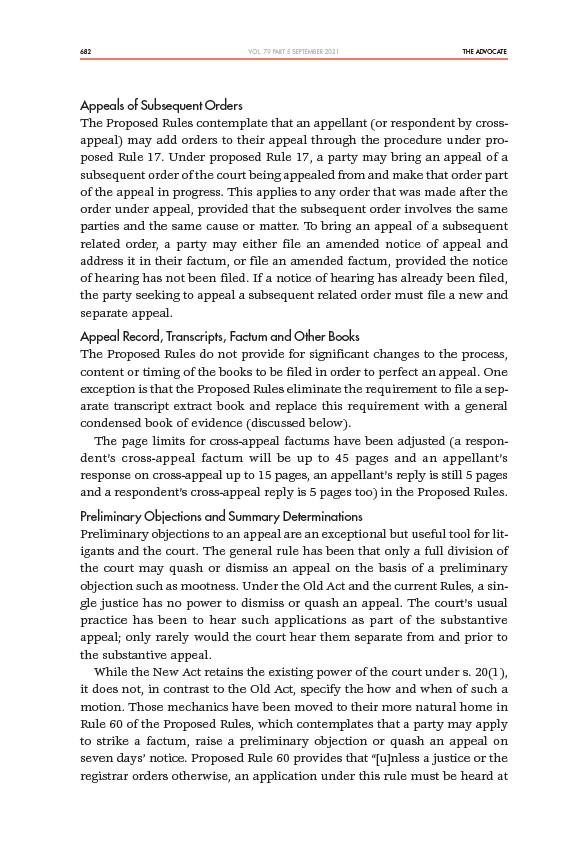
682 THE ADVOCATE
VOL. 79 PART 5 SEPTEMBER 2021
Appeals of Subsequent Orders
The Proposed Rules contemplate that an appellant (or respondent by crossappeal)
may add orders to their appeal through the procedure under proposed
Rule 17. Under proposed Rule 17, a party may bring an appeal of a
subsequent order of the court being appealed from and make that order part
of the appeal in progress. This applies to any order that was made after the
order under appeal, provided that the subsequent order involves the same
parties and the same cause or matter. To bring an appeal of a subsequent
related order, a party may either file an amended notice of appeal and
address it in their factum, or file an amended factum, provided the notice
of hearing has not been filed. If a notice of hearing has already been filed,
the party seeking to appeal a subsequent related order must file a new and
separate appeal.
Appeal Record, Transcripts, Factum and Other Books
The Proposed Rules do not provide for significant changes to the process,
content or timing of the books to be filed in order to perfect an appeal. One
exception is that the Proposed Rules eliminate the requirement to file a separate
transcript extract book and replace this requirement with a general
condensed book of evidence (discussed below).
The page limits for cross-appeal factums have been adjusted (a respondent’s
cross-appeal factum will be up to 45 pages and an appellant’s
response on cross-appeal up to 15 pages, an appellant’s reply is still 5 pages
and a respondent’s cross-appeal reply is 5 pages too) in the Proposed Rules.
Preliminary Objections and Summary Determinations
Preliminary objections to an appeal are an exceptional but useful tool for litigants
and the court. The general rule has been that only a full division of
the court may quash or dismiss an appeal on the basis of a preliminary
objection such as mootness. Under the Old Act and the current Rules, a single
justice has no power to dismiss or quash an appeal. The court’s usual
practice has been to hear such applications as part of the substantive
appeal; only rarely would the court hear them separate from and prior to
the substantive appeal.
While the New Act retains the existing power of the court under s. 20(1),
it does not, in contrast to the Old Act, specify the how and when of such a
motion. Those mechanics have been moved to their more natural home in
Rule 60 of the Proposed Rules, which contemplates that a party may apply
to strike a factum, raise a preliminary objection or quash an appeal on
seven days’ notice. Proposed Rule 60 provides that “unless a justice or the
registrar orders otherwise, an application under this rule must be heard at